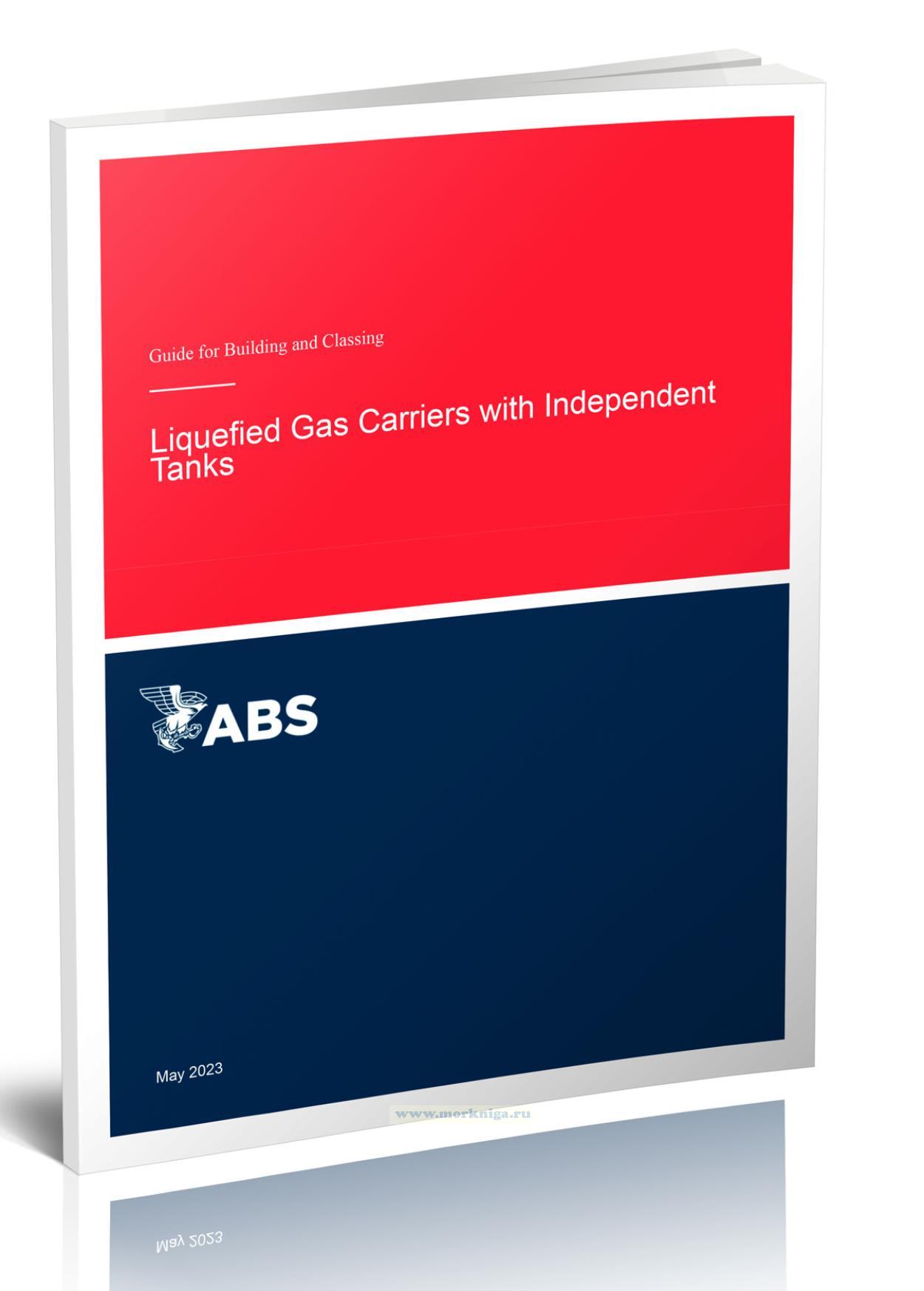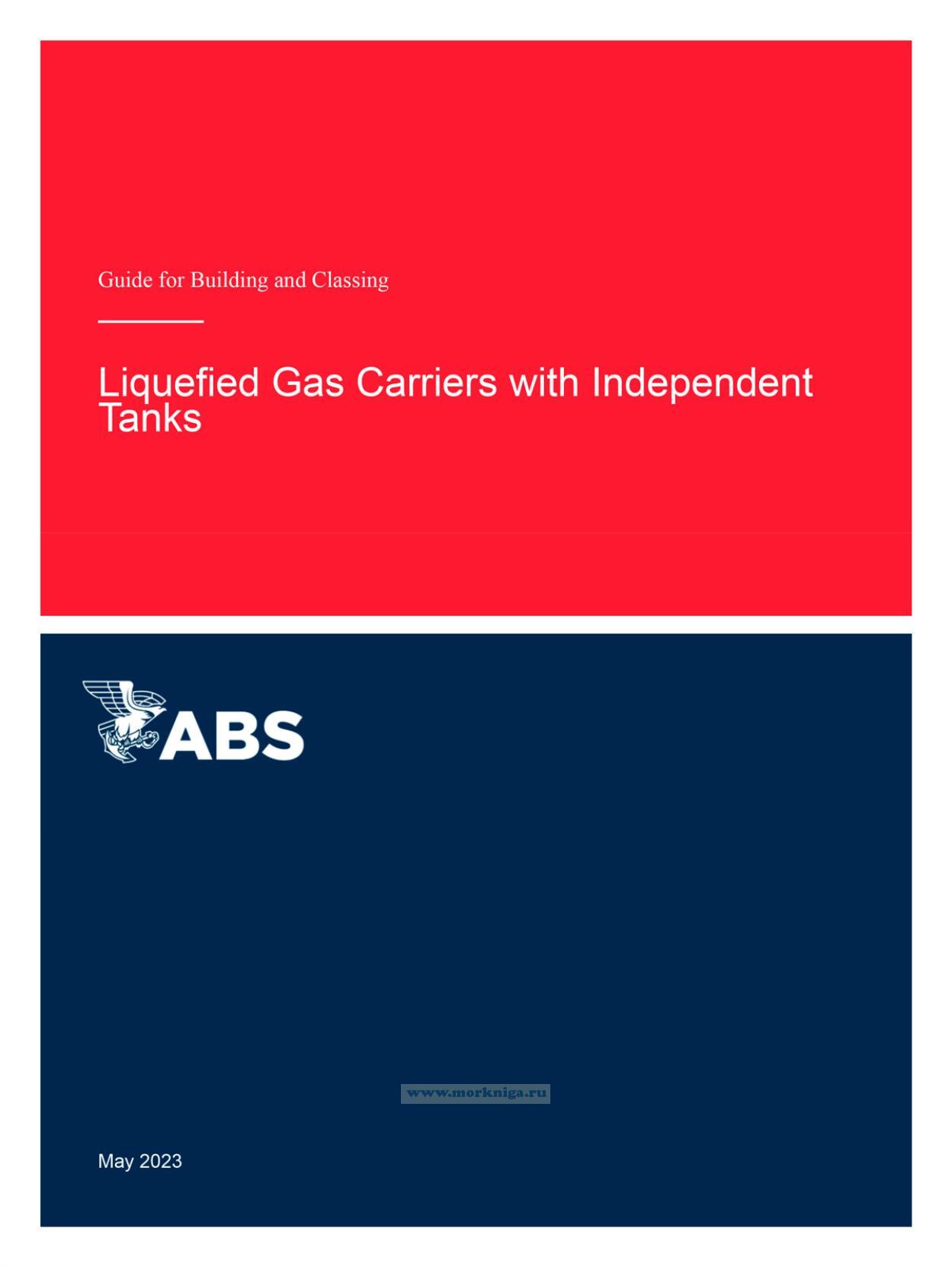ABS Guide for Building and Classing Liquefied Gas Carriers with Independent Tanks/–†—É–ļ–ĺ–≤–ĺ–ī—Ā—ā–≤–ĺ ABS –Ņ–ĺ —Ā—ā—Ä–ĺ–ł—ā–Ķ–Ľ—Ć—Ā—ā–≤—É –ł –ļ–Ľ–į—Ā—Ā–ł—Ą–ł–ļ–į—Ü–ł–ł —Ā—É–ī–ĺ–≤ –ī–Ľ—Ź –Ņ–Ķ—Ä–Ķ–≤–ĺ–∑–ļ–ł —Ā–∂–ł–∂–Ķ–Ĺ–Ĺ–ĺ–≥–ĺ –≥–į–∑–į —Ā –Ĺ–Ķ–∑–į–≤–ł—Ā–ł–ľ—č–ľ–ł —Ä–Ķ–∑–Ķ—Ä–≤—É–į—Ä–į–ľ–ł
–ö–Ĺ–ł–≥–į –Ĺ–į –į–Ĺ–≥–Ľ–ł–Ļ—Ā–ļ–ĺ–ľ —Ź–∑—č–ļ–Ķ
The industry and ABS share a large and successful body of experience with liquefied gas carriers with independent tanks. Owners and designers familiar with the benefits of the ABS SafeHull Rule approach in the design and analysis of other vessel types requested that ABS adapt the SafeHull criteria so that it can be used in the Classification of liquefied gas carriers with independent tanks. This Guide is developed and issued in response to the request.
This Guide provides criteria that can be applied in the Classification of the hull structure of a liquefied gas carrier with independent tanks.
The strength criteria contained herein are to be used to verify compliance with the structural analysis requirements in the International Code for the Construction and Equipment of Ships Carrying Liquefied Gases in Bulk (IGC Code) as a condition of classification. These strength criteria are to be considered supplementary to those for corresponding aspects of Classification as given in Part 5C, Chapter 8 of the ABS Rules for Building and Classing Marine Vessels (the Rules). The Owner may select to use either this Guide or Part 5C, Chapter 8 of the Rules, however the Classification symbol. SH. (signifying compliance with the SafeHull based criteria in this Guide) will only be granted when the design is based on the criteria of this Guide.
Contents
Section 1 Introduction
1 General
Table1 Design Ambient Temperatures (1 May 2009)
Table 2 Cargo Properties of Common Liquefied Gas Cargoes (1 May 2009)
Figure 1
Section 2 Design Considerations and General Requirements
1 General Requirements
Section 3 Dynamic Load Criteria
1 General
3 Definitions
5 Vertical Wave-induced Bending Moment
7 Horizontal Wave-induced Bending Moment
9 External Pressure
11 Internal Pressure
13 Impact Loads
15 Thermal Loads
17 Loads Associated with Construction and Installation (1 June 2017)
Table 1 klo Coefficient
Figure 1 Tank Coordinate System for Internal Pressure
Figure 2 Distribution Factor for Vertical Wave-induced Bending Moment mv
Figure 3 Distribution Factor for Horizontal Wave-induced Bending Moment mh
Figure 4 Pressure Distribution Function klo
Figure 5 External Pressure Calculation Points
Figure 6 Acceleration Ellipse (1 June 2017)
Figure 7 Determination of Internal Pressure Heads (1 June 2017)... Figure 8 Definition of Bow Geometry (1 May 2009)
Figure 9 Definition of Bowflare Geometry for Bowflare Shape Parameter
Figure 10 Ship Stem Angle, y
Figure 11 Definition of Tank Geometry
Section 4 Standard Design Load Cases
1 Symbols (1 June 2017)
3 Standard Design Load Cases for Yielding and Buckling Strength Assessment (1 May 2009)
5 Standard Design Load Cases for Fatigue Strength
Assessment
Table 1 Standard Design Load Cases for Yielding and Buckling Strength Assessment (Load Combination Factors for Dynamic Load Components)
Table 2 Standard Design Load Cases for Yielding and Buckling Strength Assessment (1 May 2009)(Load Combination Factors for Port and Accidental Load Cases)
Table 3 Standard Design Load Cases for Fatigue Strength Assessment (1 May 2009)(Load Combination Factors for Dynamic Load Components for Full Cargo Loading Condition)
Table 4 Standard Design Load Cases for Fatigue Strength
Assessment (1 May 2009)(Load Combination Factors for Dynamic Load Components for Ballast Loading Condition)
Figure 1 Direction of Internal Pressure due to Acceleration
Figure 2 Loading Pattern (Yielding and Buckling Strength Assessment)
Section 5 Initial Scantling Criteria
1 General
3 Hull Girder Strength
5 Shearing Strength
7 Hull Structures
9 Independent Cargo Tank Structures
11 Supports
Figure 1 Unsupported Span of Side Frame
Figure 2 Unsupported Span of Longitudinals
Figure 3 Effective Breadth of Plating be
Section 6 Acceptance Criteria
1 General
3 Symbols
5 Yielding Failure Mode
7 Failure Criteria - Buckling and Ultimate Strength
9 Fatigue Damage
Table 1 Allowable Stresses (kgf/cm2) for Watertight Boundaries (1 May 2009)
Table 2 Allowable Stresses (kgf/cm2) for Various Finite Element Mesh Sizes (1 May 2009)
Table 3 Allowable Stresses (kgf/cm2) for Various Finite Element Mesh Sizes
Figure 1 Coordinate System for Buckling Strength Evaluation
Appendix 1 Structural Modeling and Analysis
Appendix 2 Calculation of Critical Buckling Stresses
Appendix 3 Rule-based Fatigue Strength Assessment
Appendix 4 Hull Girder Ultimate Strength Assessment (1 January 2010)
Appendix 5 Fatigue and Fracture Analysis for Type-B Independent Tanks (1 June 2011)

